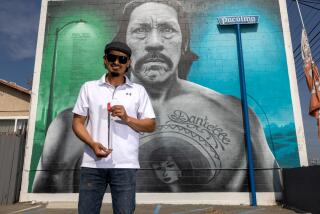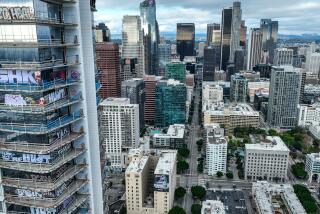Art From the Inside : Inmates’ Achievements in Painting, Sculpture on View at City Hall Gallery
Issa Beamon has spent the last 26 months in prison and has another nine months to go, so of course he hasn’t had a chance to view the current art exhibit at Los Angeles City Hall.
If he could, he would see a whole spectrum of society, from movers and shakers to average passers-by, admire his brilliantly colored abstract montage of musical instruments, called “Hear It With Your Eyes,” or his poignant oil of a mother at the piano and father and son playing checkers, “An Evening In.”
“And you know what?” Beamon, 55, boasts in a telephone interview from the California Institution for Men at Chino. “I’ve got some things I’m just now finishing that I think are a lot better than what’s hanging in the gallery.”
Starving artists, maybe, but criminal artists?
Beamon is one of nine inmates whose art works--”Images from Inside”--are on display through Friday in the Bridge Gallery, which spans Main Street between City Hall and Parker Center.
More than two dozen of their works line the enclosed pedestrian bridge, which doubles as one of seven public art galleries operated by the city’s Department of Cultural Affairs.
Along the hallway are loud, abstract splashes of acrylic; landscapes in muted, pastel shades; classic scenes of the Southwest; gentle, ceramic sculptures of woman and child, intriguing self-portraits.
Comical Scenes
Some scenes are comical, like the depiction of “Hercules Penitentiary.” Some are wistful, like Beamon’s oil, “If God Wills,” which shows in the background a man staring through bars looking at a waterfall. And some offer not-so-subtle double-entendres, like the sweeping landscape of the woman pulling a donkey across the desert titled, “Leading an Ass Through Life.”
City officials say they were hesitant when first approached with the idea of displaying the inmate art. The Bridge Gallery, after all, is booked a year or more in advance by individual and groups of artists, and it may not be the most appropriate venue to present the work of a bunch of amateur artists who are sentenced to prison for affronting the very society that City Hall represents.
Won’t their works of art reflect anger? Sulking? Resentment?
Scott Canty, the gallery’s curator, viewed the art and decided it was worthy of a place of public prominence.
“They’re in prison for whatever reason, and if art is a way for them to escape that and hopefully change their way of thinking about the world, then hey, let’s do a show,” Canty said.
“If you look at their art, you don’t see anything depressing. It looks like they’re trying to escape through their art. It’s a wonderful exhibit. If wedidn’t call it prison inmate art, people who walk through here wouldn’t know those artists were in jail or out of jail. It’s artwork, from the heart.”
Added Rodney Punt, assistant general manager of the city’s Department of Cultural Affairs:
“This is certainly one of the more unusual group shows we’ve had. But it’s received more positive comments than have the past half-dozen shows we’ve had. Everyone is impressed by how representational the art is.
“The art is surprisingly optimistic, upbeat and serene,” Punt said. “And it reflects superb, gorgeous craftsmanship. Much of it is commercially viable.”
Not Unique
The nine inmates are not unique within the prison population, officials say. Of 75,000 inmates in the state’s penal system, about 8,000 of them are participating in an 8-year-old Arts-in-Corrections program to encourage development of the fine arts behind bars, said Bill Cleveland, art program director for the state Department of Corrections.
An even larger display of inmate art will be shown Jan. 17 through Feb. 3 at the Claremont Graduate School in Claremont.
While it is painting and sculpture that go on display, the fine arts program is not limited to those. Other inmates study improvisational theater, graphic arts, dance, poetry and even juggling.
Less Troublesome Inmates
One study of the effect of the arts program shows that its participants cause fewer problems in prison because they spend most of their free time in an arts room, focused on their canvas or ceramics or music. Another study showed that among those prisoners who finish their terms and are free on parole, those who were involved in the arts program were significantly less likely to violate parole and return to prison.
“The average inmate has a lack of self-discipline, is extremely unsuccessful in life, has low self-esteem and doesn’t have a lot of experience in working on projects through completion,” Cleveland said.
“An artist, on the other hand, is highly self-disciplined, highly motivated, can make a commitment to a project and has high standards of quality,” he said.
One of those artists is Anna Arias, 39, who spent 1 1/2 years in prison for drug dealing and who recently was released on parole. Hers is among the work on display in the Bridge Gallery.
“That art program was a lifesaver for me,” she said. “If it hadn’t been there, my whole time in prison would have been a waste. Instead, I was able to regroup myself and concentrate on my art. I painted all the time.”
One of her paintings depicts a comfortable, nicely furnished living room, and the viewer’s attention is drawn to a fishbowl. In it is a tiny mermaid. The title of the painting: “For the Man Who Has Everything.”
More to Read
The biggest entertainment stories
Get our big stories about Hollywood, film, television, music, arts, culture and more right in your inbox as soon as they publish.
You may occasionally receive promotional content from the Los Angeles Times.










